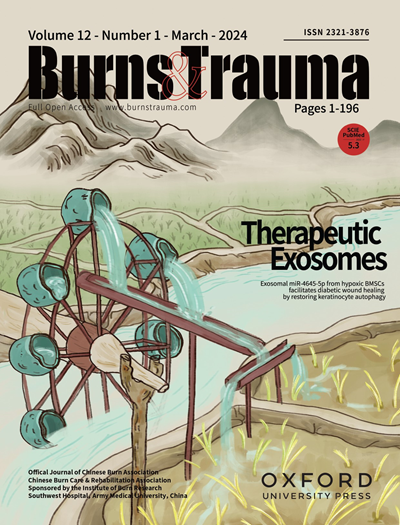严重烧伤成人服用β受体阻滞剂和奥昔诺龙的效果:RE-ENERGIZE 试验的事后分析
IF 6.3
1区 医学
Q1 DERMATOLOGY
引用次数: 0
摘要
背景 在严重烧伤儿童中进行的前瞻性随机试验表明,奥昔洛酮(OX)、β受体阻滞剂(BB)以及这两种药物的复方制剂(BBOX)对烧伤后短期和长期的高代谢、分解代谢和高炎症反应有积极的作用。虽然缺乏关于严重烧伤成人的对比数据,但 BB、OX 和 BBOX 似乎是这类患者的常用药物。在本研究中,我们对一个国际前瞻性随机试验数据集进行了二次分析,以提供有关目前使用 OX、BB 和 BBOX 的模式和潜在治疗效果的描述性证据。方法 RE-ENERGIZE(RandomizEd Trial of ENtERal Glutamine to minimIZE Thermal Injury,NCT00985205)试验纳入了 1200 名成年重度烧伤患者。我们根据患者在急性住院期间服用 OX、BB、BBOX 或未服用上述药物(无)的情况对患者进行了分层。描述性统计描述了药物治疗的详细情况,未调整分析确定了各组药物使用的易感因素。使用调整后的多变量 Cox 回归法模拟了 OX、BB 和 BBOX 与临床结果(如出院存活时间和 6 个月死亡率)之间的关系。结果 在所有参加试验的患者中,超过一半的患者接受了 OX(138 人)、BB(293 人)或 BBOX(282 人)治疗,而无患者接受治疗(487 人,40.6%)。每个研究地点和地理区域使用 OX、BB 和 BBOX 的情况差异很大。使用OX、BB和BBOX的诱发因素包括烧伤的总体表面积(TBSA)较大、入院时急性生理学和慢性健康评估(APACHE)II评分较高以及患者年龄较小。在对多个协变量进行调整后,使用 OX 与更长的出院存活时间相关[每增加 100%,危险比 (HR) 为 0.62,置信区间 (CI) 为 (0.47-0.82),p = 0.001]。BB天数比例越高,院内死亡率(HR:0.5,CI 0.28-0.87,p = 0.015)和6个月死亡率(HR:0.44,CI 0.24-0.82,p = 0.01)越低。结论 在成年烧伤患者中,使用 OX、BB 和 BBOX 是很常见的,但全球各地的使用情况差异很大。我们的研究结果发现,成人烧伤患者的预后与使用 BB 和 OX 的关系不一,使用 BB 的急性期死亡率和 6 个月死亡率较低,而使用 OX 的患者出院时间较长。我们建议进一步研究这些药物对严重烧伤病理生理反应的调节作用。本文章由计算机程序翻译,如有差异,请以英文原文为准。
Administration and effects of beta blockers and oxandrolone in severely burned adults: a post hoc analysis of the RE-ENERGIZE trial
Background Prospective randomized trials in severely burned children have shown the positive effects of oxandrolone (OX), beta blockers (BB) and a combination of the two (BBOX) on hypermetabolism, catabolism and hyperinflammation short- and long-term post-burn. Although data on severely burned adults are lacking in comparison, BB, OX and BBOX appear to be commonly employed in this patient population. In this study, we perform a secondary analysis of an international prospective randomized trial dataset to provide descriptive evidence regarding the current utilization patterns and potential treatment effects of OX, BB and BBOX. Methods The RE-ENERGIZE (RandomizEd Trial of ENtERal Glutamine to minimIZE Thermal Injury, NCT00985205) trial included 1200 adult patients with severe burns. We stratified patients according to their receipt of OX, BB, BBOX or none of these drugs (None) during acute hospitalization. Descriptive statistics describe the details of drug therapy and unadjusted analyses identify predisposing factors for drug use per group. Association between OX, BB and BBOX and clinical outcomes such as time to discharge alive and 6-month mortality were modeled using adjusted multivariable Cox regressions. Results More than half of all patients in the trial received either OX (n = 138), BB (n = 293) or BBOX (n = 282), as opposed to None (n = 487, 40.6%). Per study site and geographical region, use of OX, BB and BBOX was highly variable. Predisposing factors for the use of OX, BB and BBOX included larger total body surface area (TBSA) burned, higher acute physiology and chronic health evaluation (APACHE) II scores on admission and younger patient age. After adjustment for multiple covariates, the use of OX was associated with a longer time to discharge alive [hazard ratio (HR) 0.62, confidence interval (CI) (0.47–0.82) per 100% increase, p = 0.001]. A higher proportion of days on BB was associated with lower in-hospital-mortality (HR: 0.5, CI 0.28–0.87, p = 0.015) and 6-month mortality (HR: 0.44, CI 0.24–0.82, p = 0.01). Conclusions The use of OX, BB and BBOX is common within the adult burn patient population, with its use varying considerably across sites worldwide. Our findings found mixed associations between outcomes and the use of BB and OX in adult burn patients, with lower acute and 6-month-mortality with BB and longer times to discharge with OX. Further research into these pharmacological modulators of the pathophysiological response to severe burn injury is indicated.
求助全文
通过发布文献求助,成功后即可免费获取论文全文。
去求助
来源期刊

Burns & Trauma
医学-皮肤病学
CiteScore
8.40
自引率
9.40%
发文量
186
审稿时长
6 weeks
期刊介绍:
The first open access journal in the field of burns and trauma injury in the Asia-Pacific region, Burns & Trauma publishes the latest developments in basic, clinical and translational research in the field. With a special focus on prevention, clinical treatment and basic research, the journal welcomes submissions in various aspects of biomaterials, tissue engineering, stem cells, critical care, immunobiology, skin transplantation, and the prevention and regeneration of burns and trauma injuries. With an expert Editorial Board and a team of dedicated scientific editors, the journal enjoys a large readership and is supported by Southwest Hospital, which covers authors'' article processing charges.
 求助内容:
求助内容: 应助结果提醒方式:
应助结果提醒方式:


